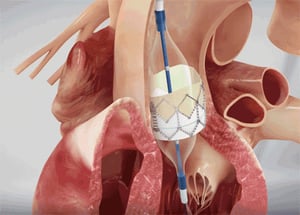PROCEDURES
TRADITIONAL AND INNOVATIVE PROCEDURES
A LOT OF PATIENTS HAVE A SINGLE PROBLEM THAT IS TYPICALLY A NARROW AORTIC VALVE OR CORONARY ARTERY DISEASE. THESE PEOPLE ARE EMINENTLY SUITABLE FOR TRADITIONAL OPEN HEART SURGERY FROM WHICH THEY GET AN EXCELLENT RESULT.
HOWEVER, THERE ARE A GROWING NUMBER OF PATIENTS WITH OTHER SIGNIFICANT MEDICAL CONDITIONS THAT MAY PRELUDE THEM FROM HAVING OPEN HEART SURGERY SAFLEY WITH A MEANINGFUL RECOVERY TO INDEPENDENT LIFE. FOR THESE PEOPLE, OPEN HEART SURGERY - A HIGHLY INVASIVE PROCEDURE THAT REQUIRES OPENING OF THE CHEST - IS NEEDED TO REPAIR OR REPLACE THE VALVE. FOR THESE REASONS, LESS INVASIVE WAYS OF TREATING MITRAL REGURGITATION AND AORTIC STENOSIS ARE BEING DEVELOPED.
TRANSCATHETER AORTIC VALVE IMPLANMENTATION (TAVI)
Transcatheter aortic valve implantation (TAVI) is a revolutionary procedure that allows us to replace the aortic valve without open heart surgery. TAVI is percutaneous (performed through the skin) treatment for aortic stenosis which involves inserting an artificial aortic heart valve without open-heart surgery.

The TAVI procedure is where a heart valve that is crimped into a catheter is introduced through the artery in the groin (femoral artery) and then positioned in the diseased aortic valve. The new transcatheter aortic valve expands to fit within the diseased valve. The diseased aortic valve will not be cut or removed. The new valve will start to function immediately. For patients whose femoral arteries are too small to accommodate the new valve, we often introduce the trans-catheter valve between the ribs, across the apex of the heart – this is called a transapical approach.
We have had no mortality on these transapical procedures and our results are world-leading.
In most cases the patient is usually up and about the next day. Often, a patient is home within three to four days.
TAVI has revolutionised our ability to treat patients who are at increased risk for open surgery.
It provides new options to the growing number of elderly patients, and patients who have had previous cardiac surgery, poor lung function or other issues that may preclude them from having traditional open surgery safely.
TRANSCATHETER MITRAL VALVE REPLACEMENT (TMVr)
Through a little vein in the groin, we can now apply something that is a bit like a clothing peg to clip exactly where the valve leaflets don’t meet. This keyhole procedure, called MitraClipTM, reduces the mitral valve leak significantly, but is associated with much less risk than conventional surgery.
.png)
MitraClip is a simple procedure to fix your mitral valve. It is a minimally invasive procedure that does not require opening of the chest. The mitral valve is accessed with a catheter (thin tube) that is guided in through a vein in your leg to reach your heart.
The small clip is attached to your mitral valve exactly where the valve leaflets don't meet. The device assists in restoration of normal blood flow to your heart.
On average, the procedure takes 1-3 hours. Most patients are able to go home within 1-3 days.1
1.Lim DS et al. Contemporary Outcomes with MitraClip (NTRXTR) System In Primary Mitral Regurgitation Results From The Global EXPAND, ACC 2020.
The MitraClip innovation is a world-leading minimally invasive transcatheter mitral valve repair (TMVr) device. This treatment is a revolutionary option for people living with mitral regurgitation (MR). It is especially transformative for geriatric patients who are unable to withstand the invasion of traditional open-heart surgery.
On 1 July 2021, the Australian government has provided funding through the Medicare Benefits Schedule (MBS) for TMVr with the MitraClip device to be undertaken by TMVr accredited clinicians in accredited hospitals. The MBS supported indications for TMVr include high surgical risk patients with:
- Moderate-to-severe or severe symptomatic degenerative (primary) mitral regurgitation; or
- Moderate-to-severe or severe symptomatic functional (secondary) mitral regurgitation
This national funding is a significant step forward in providing greater access for MR patients to TMVr in appropriately credentialed Structural Heart Programs such as Macquarie University Hospital (MUH) and Royal Prince Alfred Hospital (RPAH).
The Sydney Heart Team is able to assess the patients who are most suitable for having traditional open heart surgical techniques or having the trans-catheter techniques. It’s why both of the outcomes we have with open heart surgery and trans-catheter heart surgery are extremely good.